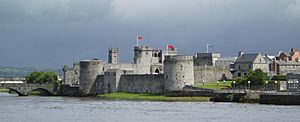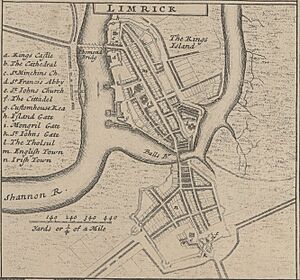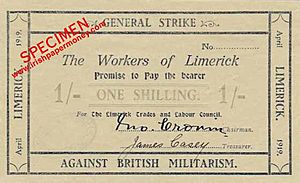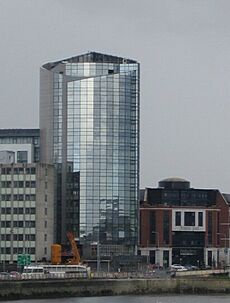History of Limerick facts for kids
The history of Limerick began when Vikings settled there in 812. They built a walled city on King's Island, which is an island in the River Shannon. Limerick officially became a city in 1197.
King John ordered a huge castle to be built around 1200. The city faced attacks three times in the 1600s. The last big battle led to the famous Treaty of Limerick in 1691. After this, many defeated Catholic leaders left Ireland. Much of the city was built during a rich period called the Georgian era. This time ended when Ireland joined with Britain in 1800. Today, Limerick is a growing city with people from many different backgrounds.
Contents
- What's in a Name?
- Limerick's Early Days
- Viking Settlers Arrive
- Norman Influence and Castle Building
- Battles and a Famous Treaty
- Georgian Limerick: A New Look
- The Great Famine's Impact
- A Boycott in Limerick
- Fighting for Independence
- The Irish Free State is Born
- The "Emergency" Years
- After the War
- The Celtic Tiger Years
- After the 2008 Crash
What's in a Name?
The name Luimneach first described the area along the Shannon Estuary. This area was called Loch Luimnigh. The first settlements on King's Island, before and during Viking times, were known by other names like Inis Sibhtonn.
The name Luimneach has been around since at least 561. Its exact meaning is not clear. Early English spellings like Limnigh were closer to the Irish sound. Some people think the name means "a bare or empty piece of land." Others suggest it comes from a word meaning "a bare marsh" or "a spot made bare by horses eating there."
Limerick's Early Days
We don't have many written records about Limerick's very early history. This is partly because the Vikings often destroyed Irish records. However, old stories and some maps give us clues. The earliest proven settlement was in 812. But there were likely even older communities around King's Island.
An ancient map-maker named Ptolemy drew the earliest map of Ireland in 150 AD. It showed a place called "Regia" where King's Island is now. History also mentions a big battle in 221 and a visit by St. Patrick in 434. Saint Munchin, Limerick's first bishop, died in 652. This shows the city was important even then. In 812, Danish Vikings sailed up the Shannon. They attacked the town and burned a monastery. But the Irish fought back and made them leave.
Viking Settlers Arrive
The first time we hear about Vikings in Limerick was in 845. They were reported in the Annals of Ulster. Vikings were seen in the area many times in the 800s. A lasting settlement in Limerick started by 922. That year, a Viking prince named Tomrair mac Ailchi led the Limerick fleet. They raided places along the River Shannon, from Lough Derg to Lough Ree.
Two years later, Vikings from Dublin attacked Limerick but were pushed back. The war between Dublin and Limerick continued. In 937, the Dublin Vikings captured Limerick's king and destroyed his ships. Some think this was not a battle, but a way for Dublin to get Limerick's help in a fight against Athelstan of England. The 920s and 930s were a strong time for Viking power in Ireland. Only Limerick was as powerful as Dublin then.
The last Norse King of Limerick was Ivar of Limerick. He was a big enemy of Mathgamain mac Cennétig and his famous brother Brian Boru. Brian Boru's family defeated Ivar. After killing Ivar, Brian Boru took over Limerick. He wanted to make it the new capital of his kingdom.
The Vikings never got their full power back. They became a smaller group. But they often played key roles in the many power struggles of the next few centuries.
Norman Influence and Castle Building

The arrival of the Normans in 1173 changed everything. Domnall Mór Ua Briain, the last King of Limerick, burned the city in 1174. He did this to stop the new invaders from taking it. After he died in 1194, the Normans finally took control in 1195. This was led by Prince John.
In 1197, King Richard I of England gave Limerick its first official city rules. Its first Mayor, Adam Sarvant, was chosen ten years before London had one. A castle, ordered by King John and named after him, was finished around 1200. With the peace brought by Norman rule, Limerick grew as a port and trading center.
By this time, the city had two parts. "English Town" was on King's Island, surrounded by strong walls. "Irish Town" was on the south bank of the river, where Irish and Danes lived. In 1216, King John gave more land north and south of the river to the city. Walls were started around Irishtown around 1395, but they weren't finished until the late 1400s.
Limerick even had its own mint to make coins in 1467. A document from 1574 described Limerick as "stronger and more beautiful than all the other cities of Ireland." It had "stout walls of hewn marble." The document also said its houses were "of square stone of black marble and built in the form of towers and fortresses."
Another writer, Luke Gernon, described Limerick in 1620. He called its buildings "lofty... of marble." He said the main street was "magnificent" and "did amaze me."
In the 1400s and 1500s, Limerick became like its own small city-state. It was separate from the main English-controlled area called the Pale. But the British Crown still held power. During the English Reformation, there were disagreements. Some people stayed loyal to the Catholic Church. Others supported the new state religion, the Church of Ireland.
Battles and a Famous Treaty
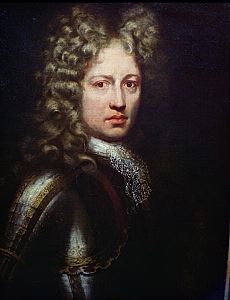
Limerick was attacked many times in the 1600s. The first time was in 1642. Irish forces took King John's Castle from the English soldiers. In 1651, Oliver Cromwell's army, led by Henry Ireton, attacked the city. Limerick had supported the Irish side since 1642. The city's defenders supported Charles II. The attackers fought for a new government without a king. Many people died from hunger and sickness. After heavy bombing, the city gave up in October 1651.
Later, in the Williamite war in Ireland, French and Irish soldiers gathered behind Limerick's walls. This was after the Battle of the Boyne in 1690. The city's old walls were in bad shape. The attackers, led by William III, had 20,000 soldiers. But they lost their big guns in an attack by Patrick Sarsfield. The fighting was fierce. The walls were broken three times, but the defenders held strong. William's army eventually left.
William's forces came back in August 1691. Limerick was the last place held by the Catholic supporters of King James II. Sarsfield was in charge. French help did not arrive by sea. After 850 defenders were killed on Thomond Bridge, the city asked for peace. On October 3, 1691, the famous Treaty of Limerick was signed. It was signed on a large stone on the bridge. The treaty allowed the Irish soldiers to leave with full honors and sail to France.
Two days later, French help finally arrived. Sarsfield was asked to keep fighting, but he refused. He wanted to stick to the treaty. Sarsfield sailed to France with 19,000 soldiers. They formed the Irish Brigade. Later, the treaty was broken by William's side. Because of this, Limerick became known as The City of the Violated Treaty. This is still a source of sadness in the city today.
Georgian Limerick: A New Look
In 1695, new laws called penal laws were put in place. These laws stopped Catholics from holding public jobs, buying land, voting, or openly practicing their religion. But Limerick was still the main port in western Ireland. So, the city, especially the rich Protestant families and Catholic traders, started to do well.
Trade across the Atlantic Ocean was very important. Limerick made money from this trade. Many important public buildings and projects were paid for with local trade taxes. The first hospital was started in 1761. A poorhouse and hospital were built in 1774.
The late 1600s and early 1700s saw Limerick grow quickly. It began to look like a Georgian city. This is when the city center got its current look. Planned rows of Georgian houses became a key feature. This new part of the city was called Newtown Pery. It was designed by Davis Ducart in 1765 for Edmund Sexton Pery.
Newtown Pery was built in stages. Pery sold land to builders who put up tall, elegant houses. The streets were wide and straight. O'Connell Street became the center of this new town. Some of Ireland's best Georgian buildings are in the Crescent area and Pery Square. A basic sewer system was also built. By the time of King George III, Limerick had 17 gates in its city walls. Many modern street names still remember these gates.
New docks and bridges were built too. Ships brought in wood, coal, iron, and tar. They exported beef, pork, wheat, and flour. Many people also left from Limerick to go to North America. During the Great Irish Famine, food was still sent out of the port. Soldiers often had to protect the port from hungry people.
The rich families quickly moved to the new, wide streets of Newtown Pery. They left the old, crowded parts of medieval Limerick. These older areas became poor and dirty. Sadly, some old buildings were lost because they were not looked after.
The Great Famine's Impact
We don't know exactly how many people in the Limerick area died during the Great Irish Famine. Across Ireland, the population dropped by about 20%. Half of these people died, and half left the country. While the famine caused 70,000 people to leave County Limerick, the city's population actually grew a little. This was because people moved to the city's workhouses for help.
Ships in Limerick's port were ready to carry food from the rich farmlands of the Golden Vale to English ports. Francis Spaight, a Limerick merchant, recorded huge amounts of oats and wheat being shipped out between June 1846 and May 1847. He even said that the potato crop failure was helpful for getting rid of the poor population through emigration.
The same docks were where many ships left for America. In one week in April 1850, four ships sailed down the Shannon towards the Americas. These ships carried 357 people, mostly young men and women. They took their energy and skills to other countries instead of Ireland. One small ship, the Hannah, was only 59 feet long. It could barely hold 60 passengers and eight crew. Yet, it made eight trips across the Atlantic.
A Boycott in Limerick
A small number of Lithuanian Jewish traders came to Limerick starting in 1878. They were escaping unfair treatment in their home country. At first, they were a normal part of the city's shops. They set up a synagogue (a Jewish place of worship) and a cemetery in the 1880s.
In 1904, a young Catholic priest, Father John Creagh, gave a strong speech. He told Catholics "not to deal with the Jews." After this, 32 Jewish people left Limerick. Father Creagh's leaders later disagreed with his actions. This event became known as the Limerick Boycott. It was an economic boycott against the small Jewish community for over two years. No Jewish people in Limerick were killed or seriously hurt.
Limerick's Protestants, many of whom were also traders, supported the Jewish community during this time. In the end, five Jewish families left the city, but 26 families stayed. Some of those who left went to Cork. They planned to sail from Cobh to America. The people of Cork welcomed them. Church halls were opened for them, and many stayed in Cork. Later, children and grandchildren of this group became important in Irish writing and film.
Fighting for Independence
The IRA and the independence group Sinn Féin became popular in Limerick after the harsh actions and killings of the 1916 Rising. The police often raided the homes of people thought to support Sinn Féin. Prisoners were held without trial in a camp in North Wales.
After a local republican and trade unionist named Robert Byrne was arrested and died, most of Limerick city was declared a "Special Military Area." People now needed special permits from the police to enter the city. In response, the Limerick Trades and Labour Council called for a general strike. They also boycotted the British troops. A special strike committee was set up. It even printed its own money and controlled food prices. An American army officer visiting Limerick had to get a permit from this committee to leave the city. He said, "I guess it is some puzzle to know who rules these parts."
After 14 days, the strike ended. There was a compromise on the permits issue. Open fighting broke out in April 1920 between British soldiers and the people. The soldiers used bayonets, and the people threw stones and bottles. A ceasefire between the IRA and British forces began on July 9, 1921.
The Irish Free State is Born
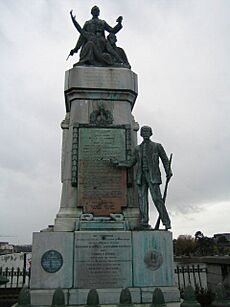
On December 5, 1921, Éamon de Valera gave a speech in Limerick. He warned people not to be too hopeful about the peace talks. A few hours later in London, Michael Collins signed the Anglo-Irish Treaty. This treaty gave limited independence to the southern part of Ireland, creating the Irish Free State. But it kept six counties in Northern Ireland as part of the UK. The treaty also gave some Irish ports to the UK for naval bases. De Valera and others strongly opposed these compromises. This set the stage for the civil war.
In Limerick, problems started when the British forces left. Three different Irish groups rushed in. Pro-Treaty soldiers were asked by the new government to take over the city. This was because they weren't sure about the loyalty of the local Limerick soldiers. The local soldiers then split into groups that were for and against the treaty.
Fighting began on William Street on July 11, 1922. Free State troops fired on the soldiers holding the Ordnance Barracks. A large store was looted. On July 17, Eoin O'Duffy arrived in Limerick with 1,500 Free State soldiers and artillery guns.
The Free State forces used an 18-pounder gun on July 19. They blasted a hole in the barracks walls and then attacked. The Castle Barracks was taken the next day. The anti-Treaty soldiers then left the city, burning the barracks they still held. Limerick Prison, built for 120 prisoners, held 800 by November. The fighting in Limerick in July 1922 killed six Free State soldiers and 12 civilians. Another 87 people were hurt.
The Civil War ended the next May with the Free State winning. De Valera and his supporters refused to join the new government until 1927.
The Free State government began to rebuild the country. They had big plans. The Shannon Scheme was a plan to build a Hydroelectric power station using the energy of Ireland's largest river. It started in 1925. A German company was given the contract. This project created jobs for 750 people. The Electricity Supply Board was set up to manage the project. It slowly brought electricity to all of rural Ireland.
The "Emergency" Years
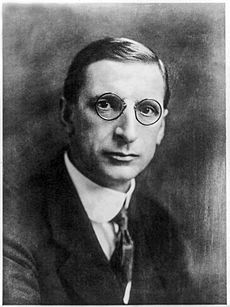
Soon after Éamon de Valera became leader in 1932, Ireland faced several "emergencies." De Valera stopped paying land debts to Britain. Britain responded by adding high taxes on Irish farm products. De Valera then added his own taxes on British goods. This started the Anglo-Irish Trade War.
Limerick's economy, which relied on farming, became very difficult. People often traded goods instead of using money. This was when Ireland started to control its economy more. The idea of letting businesses do whatever they wanted was stopped. This was because unemployment, poverty, and people leaving the country were very high. The government started new industries that were not farming-related.
In 1935, Charles Lindbergh helped plan an airport on the Shannon Estuary at Rineanna. This airport was later named Shannon Airport. In 1937, Foynes became a stop for flying boats crossing the Atlantic. During this time, the government also passed special laws to control groups like the IRA.
This first "Emergency" ended in 1938. Britain agreed to end economic taxes and return the naval ports in exchange for a payment.
The next year, World War II started. This forced Ireland to bring in new laws to control communication, media, prices, and imports. Ireland had no ships of its own and no coal, gas, or oil. Times were very hard. An army officer said that Ireland realized "the country was surrounded by water, and that the sea was of vital importance to her." Towards the end of the war, there was a shortage of rubber and petrol. This stopped all non-emergency transport, including trains, in and around the city. One lord even restarted a four-horse stagecoach route, something not seen since the 1800s.
The army grew very large, to over 300,000 soldiers. This was in case Germany or Britain tried to invade Ireland. Knockalisheen barracks was built near Limerick to house these new defense forces.
After the War
After World War II, the Limerick area's economy was largely ignored. Many people left the city and county to find work. Unemployment was very high. Except for Shannon Airport and a few related businesses, Limerick had little industry. The economy was based on farming and services. Money sent home by Irish people living abroad helped a lot. Some who left became famous, like actor Richard Harris and BBC presenter Terry Wogan.
Limerick also had some famous visitors. In 1963, US President John F. Kennedy visited Limerick during his trip to Ireland. He was given a special christening robe made of Limerick Lace. From 1956, about 500 Hungarian refugees stayed in Knockalisheen, near Limerick. They came after a failed uprising in their country. A few stayed, but most moved on to the UK and North America within a few years. This was because of the poor economy in Limerick.
Shannon Airport also attracted many different people. At this time, almost all flights across the Atlantic stopped there to refuel. A journalist named Arthur Quinlan interviewed many famous people at Shannon. He met every US president from Harry Truman to George H. W. Bush. He also taught Fidel Castro how to make an Irish coffee and interviewed Che Guevara. On March 13, 1965, Guevara suddenly arrived at the airport when his flight had mechanical problems. Quinlan interviewed him. Guevara spoke about his Irish family connections. Later, Che and his friends went to Limerick city. They came back wearing shamrocks because Limerick was getting ready for St. Patrick's Day celebrations.
In 1968, a report called the Buchanan Report was published. It suggested that economic planning should also focus on different regions. This slowly led to more investment and improvements in the Limerick area.
The Celtic Tiger Years
The big economic growth of the 1990s was called the Celtic Tiger. It made Ireland one of the richest countries in the world. This growth had started building up in the 1970s and 1980s. Shipping in the Shannon estuary grew a lot. A tanker terminal was built at Foynes, and an oil jetty at Shannon Airport. In 1982, a huge plant was built at Aughinish. It takes raw material from Africa and refines it. This refined material is then sent to Canada to be made into aluminum. In 1985, a big power plant started working at Moneypoint.
Money from the European Economic Community was used for roads and other important structures. Industrial areas were set up at Raheen and Plassey. The government worked hard to bring in many foreign companies. These included Analog Devices, Wang Laboratories, and Dell Computers. A college focused on science and engineering, called NIHE, Limerick, became the University of Limerick in 1989. The Limerick Institute of Technology was also set up. These schools helped Limerick become known as Ireland's "Silicon Valley."
In 1996, Limerick got worldwide attention. The Irish writer Frank McCourt published Angela's Ashes. He won a big award for it. The book tells about his childhood in a poor and dirty part of Limerick in the 1930s and 40s. In 1999, it was made into a movie. The poor areas in the book had long been removed. Local people felt a bit embarrassed by the sudden, unflattering talk about their city. When McCourt wrote a second book, 'Tis, people in Limerick wrote their own book called Tisn't. It showed a better side of the city.
The city has been slowly getting a new look. Two new bridges were built over the Shannon. A new tunnel also completed the orbital road around the city. Many old buildings have been replaced. Some changes, like replacing the old Cruises Hotel, caused debate. The former city architect, Jim Barrett, helped turn Limerick to face the river. Ireland's third tallest building, the 58-meter-high Riverpoint, was finished in 2006. It is near Steamboat Quay, an area with popular restaurants overlooking the Shannon.
The new wealth stopped many people from leaving Ireland. It also led to the first large-scale immigration in centuries. Now, Limerick has shops selling Russian, Chinese, South Asian, African, and Caribbean foods. Near the Crescent Shopping Centre, Limerick's first Mosque was built.
After the 2008 Crash
The global financial crisis of 2008 caused economic problems for Limerick. Like other cities in Ireland, house prices dropped by 50% from their highest points. It took more than ten years for them to recover. By 2017, the local economy was doing well again.
|


